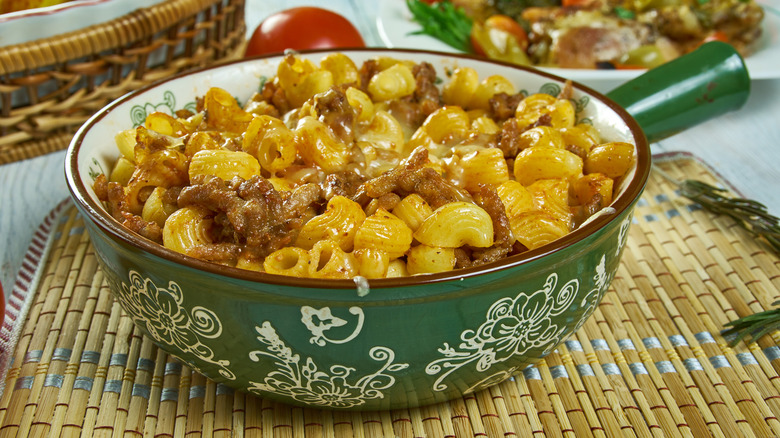
Fanfo/Shutterstock
Pasta is a beloved food not just in its home country of Italy, but also in the United States. Each year, the average American consumes approximately 20 pounds, making it one of the most popular foods. Italian American staples like fettuccine alfredo, lasagna, or spaghetti and meatballs are not only affordable to make, but also really deliver on the flavor front. The savory, cheesy, satisfying dishes make appearances on countless restaurant menus and grace the dinner tables of families across the country every night.
Other pasta dishes, however, haven't had the staying power of these classics. Certain dishes surged in popularity in the past, but have quickly fallen out of favor with the majority of restaurants and at-home chefs, whether because of flavor, complexity, or simply changes in food fads — and likely may never make their way back to restaurant menus or weekly grocery lists. Read on to learn more about some of the top vintage pasta dishes that you rarely see anymore.
1. American goulash
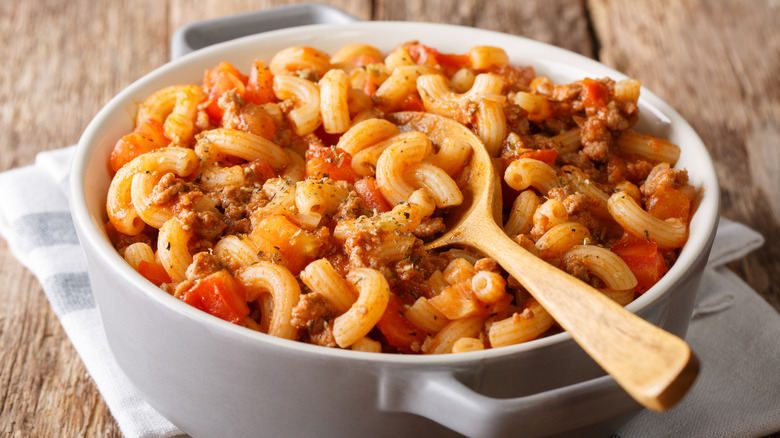
Alleko/Getty Images
Though goulash originated in Eastern Europe, the American Midwest got hold of this dish and put its own spin on it. Goulash was first introduced to the United States in the early 1900s when Hungarian immigrants began making their way into the country. Over time, the recipe evolved, and especially during the challenging times of the Great Depression, it became an affordable staple for many.
The concoction — made with macaroni, ground beef, and a savory tomato sauce — is a bit of a blend between a classic Midwestern casserole (also known as a hot dish) and beef stew. The recipe tended to vary between families and regions, with some using ground beef, while others opted for cubed beef or even ground pork. The non-negotiables, however, remained the same: a hearty protein, pasta, and a tomato-based sauce.
Though the dish is easy to cook, filling, and perfect for feeding a crowd, it's faded from its peak popularity (alongside other old-fashioned casseroles). Now, Midwestern casseroles like ham, cheese, and potato casserole or funeral potatoes tend to be more popular alternatives.
2. Spaghetti Aquitania
While recipes like spaghetti pie or baked spaghetti are still popular, there is a variant that has definitely faded from the spotlight: spaghetti Aquitania. This 1940s recipe (published by the Atlantic Macaroni Company) features an unconventional mix of spaghetti, cottage cheese, eggs, buttered bread crumbs, cream, and a mixture of veggies.
Once all the ingredients are mixed, the concoction is added to a pan and baked for about 45 minutes, and then topped with almonds before serving. The result is a congealed loaf of pasta with crispier edges and a softer center. The general consensus is that this dish seems to lack flavor, which is perhaps why it's not eaten often these days. The general thought behind the dish, however, is solid; instead of unusual add-ins like cottage cheese, many agree that more traditional Italian ingredients like ricotta cheese, ground sausage, and fresh herbs and spices would make the dish a winner.
3. Church supper spaghetti
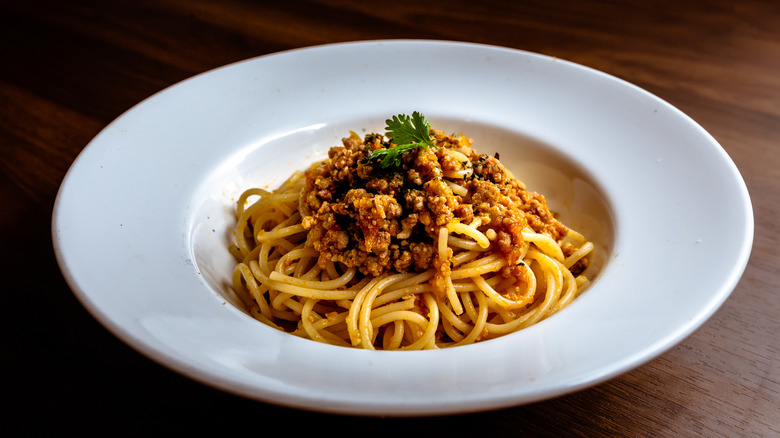
Culinaryphotography/Getty Images
This dish is a mainstay in Southern culture, with spaghetti suppers or spaghetti plate sales serving as a staple in local community-building efforts. But the spaghetti isn't always paired with red sauce and Parmesan cheese as one might expect. Instead, the star of these meals, southern spaghetti, is a blend between spaghetti and casserole. It's flavored with ground beef, onions, and bell peppers for a rich, umami taste that isn't typically associated with spaghetti. Veggies like peas, corn, and carrots (depending on who you ask) are then added and paired with canned tomatoes.
Where church supper spaghetti deviates again from classic spaghetti with Bolognese sauce is when it comes to cheese selection. Unlike Italian recipes that would typically be topped with grated Parmesan or Parmigiano Reggiano, this pasta is instead covered in shredded cheddar cheese — some recipes even call for the addition of condensed cheddar cheese soup to ramp up the flavor.
4. Haluski
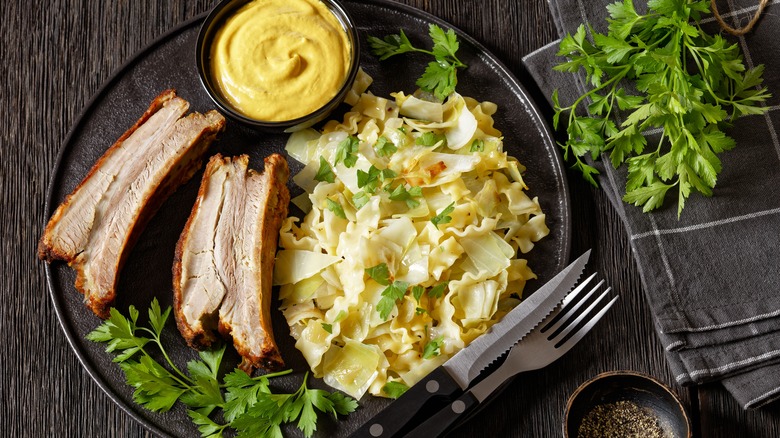
from my point of view/Shutterstock
Like many humble dishes, haluski was popular during the Great Depression thanks to its affordability and heartiness; it could easily feed a large family and stretch a weekly grocery budget as far as possible. While this dish may still be popular among those of Polish descent, it has largely faded from the limelight. (If you have a hankering for it, though, you'll likely still be able to find it being dished out at Polish food festivals or during Lent thanks to its meat-free makeup.)
The filling, satisfying meal is perfect cold-weather fare, making for a cozy dinner dish. It's made with a mix of egg noodles, green cabbage, onions, and spices and herbs like garlic and black pepper. Some recipes also call for bacon, using the bacon fat alongside butter to cook down the onions and cabbage for extra umami flavor and added saltiness. Once the vegetables have softened, cooked and drained egg noodles are mixed in (with even more butter).
5. Irish-Italian spaghetti
Though at first glance this dish may look like classic spaghetti with tomato sauce, it's actually a unique twist on the classic. Unlike the traditional version with a savory, sweet tomato sauce, this alternative features a sauce made with condensed soup, hot sauce, and spices. The unexpected combination gives the sauce an almost chili-like flavor.
It first appeared on the scene in the 1930s, when it was published in Better Homes & Gardens, and remained popular for several decades. The name, however, is a bit of a mystery. Though the spaghetti itself is Italian, most of the other ingredients don't have Italian or Irish roots. Instead, it has more of a Midwestern flair than anything else (thanks to the condensed tomato soup and cream of mushroom). Though it isn't found in many restaurants today, it is still a nostalgic favorite for many who ate it throughout their childhoods.
6. Noodles Romanoff
This retro dish was supposedly a mainstay at a famed Hollywood restaurant in the 1960s. The restaurant, Romanoff's, was popular among the A-list crowd, and many of the menu items — like blooming onion apps and classic steaks — were the talk of the town at the time. One of those dishes was the iconic Noodles Romanoff. The creamy concoction is a mix of noodles, sour cream, cream cheese, butter, spices, and Parmesan cheese. Once all the ingredients are blended, it's then baked in a casserole dish until melted and bubbling.
While the original Noodles Romanoff dish was prepared in a restaurant kitchen, it became a boxed Betty Crocker mix in the 1960s, making the dish accessible for the everyday American. It was also available from other brands like Rice-A-Roni and Stouffer's. Betty Crocker, however, discontinued its Noodles Romanoff product in the 1970s as the dish began to fade from popularity. The other pre-made variations were also pulled from shelves over the years — but luckily, the dish can still be easily homemade with all of the right ingredients if you have a craving.
7. Navy-style macaroni

Woodpond/Shutterstock
This Soviet-era dish was a staple in Russian kitchens. Rumor has it that Navy sailors ate it regularly thanks to the non-perishable nature of the ingredients, which is where this old-school dish gets its name. It became popular among laymen as well because of its affordability and filling nature — you could feed a large family without busting a budget.
The dish was traditionally made with canned meat, though modern recipes call for different cuts of beef or pork for a slightly fresher flavor. The meat is paired with chopped onions, butter, broth, or bouillon, and sometimes tomato paste (depending on the recipe). In addition to being surprisingly flavorful for how few ingredients are used, navy-style macaroni is also super fast and easy to make. Though ideal for a weeknight meal, its popularity never seemed to really take off in the United States, though the dish seems to have loyal fans among those with Eastern European roots.
8. Johnny Marzetti
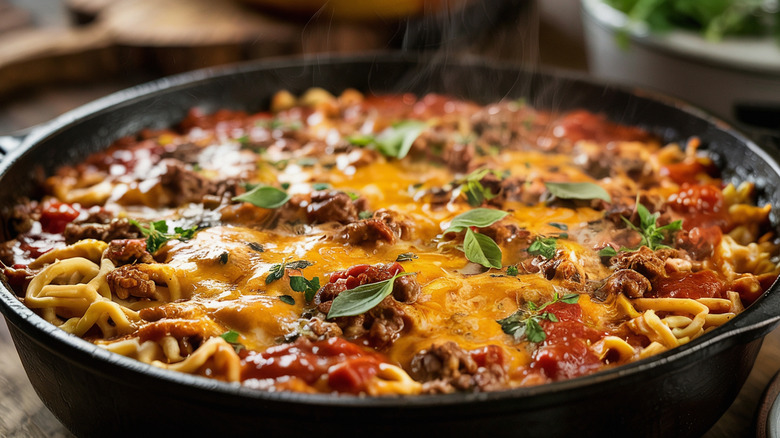
Sophie_Marie/Shutterstock
This quintessential Ohio dish is slowly fading from popularity. Named after the founder of a family-run Italian restaurant, the casserole became a Midwestern staple after gaining widespread popularity throughout the early and mid-1900s. The dish continued to pop up throughout the Midwest well into the 20th century, often appearing in school cafeterias (and making it a nostalgic meal for many Ohioans).
The satisfying casserole is a combination of ground beef, pasta, canned tomatoes, mushrooms, and a lot of shredded cheese (along with other spices and aromatics). Similar to other beef-and-pasta dishes like Hamburger Helper or chili mac and cheese, it's a hearty and impressively affordable dish — which is in part why it likely gained popularity. Though the dish may be found here and there on cafeteria menus or at family dinners, it's largely faded from the spotlight in favor of other top casseroles to make for dinner. The Marzetti company now is better known for its line of bottled dressings.
9. Southern spaghetti
It's not unusual that different regions and different cultures interpret this staple dish in their own ways. While some versions of this recipe can be traced back to about the late 1930s, others are more modern interpretations. There are baked spaghetti versions alongside regular pasta versions; all in all, there is a lot of variation in what southern spaghetti means. Regardless, it's a dish that is often associated with soul food and Black culture.
There are a few things, however, that seem to remain consistent across recipes. It is a bold, flavor-filled alternative to classic Italian spaghetti with Bolognese sauce. Typically, it is made with ground beef and filled with onions, garlic, and green bell peppers for freshness. In addition to classic seasonings like oregano and basil, recipes often call for Cajun or Creole seasoning to give a more Southern flair. The sauce almost always has a distinctive hint of sweetness from the addition of sugar, offsetting the acidity of the tomatoes and the richness of the beef. And while this dish hasn't totally disappeared, it's much less common than its traditional Italian counterpart.
10. Cowboy macaroni
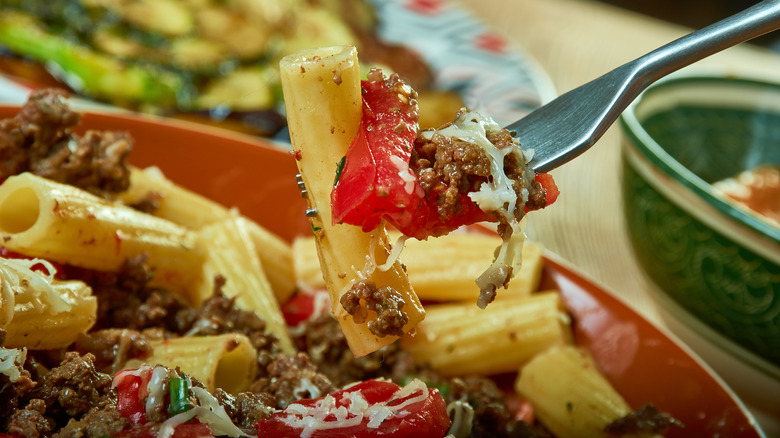
Fanfo/Shutterstock
A mix between delicious chili and classic macaroni and cheese, cowboy macaroni is good, old-fashioned comfort food. Recipes vary from person to person or family to family, but the basics remain the same: pasta, ground beef, tomato, and spices. Some prefer beans while others opt for corn, but the overall effect is the same: a Southwestern twist to an otherwise classically Midwestern meal.
This dish has a lot going for it; it's easy to make, affordable, and can feed a large crowd. You can make nearly endless variations and turn it into mac n' cheese or even cowboy pasta salad by serving it chilled. Despite this exceptional versatility, cowboy macaroni isn't a dish you'll see on a lot of menus or served at a lot of potlucks (even in the Midwest, where cozy casseroles are beloved). It's often overshadowed by its similar counterpart, chili mac n' cheese — or even just straight-up chili.
11. Macaroni loaf
A once-popular party food in the 1950s, this buttery, cheesy concoction is similar to classic mac 'n cheese. To make macaroni loaf, start with cooked pasta and mix it with a combination of eggs, cheese, and butter. Recipes vary, with some adding breadcrumbs with others adding flavor through extra condiments like mustard — or even more unconventional ingredients like hot dogs or bacon.
While the flavor is nearly identical to mac 'n cheese, where the dishes really differ is their texture. The macaroni loaf mixture is packed into a loaf pan and baked. The result is a satisfying dish with the perfect crispy edges and a savory, gooey interior. Classic mac n' cheese, on the other hand, has a more moist, wet texture of a traditional saucy pasta dish. Though macaroni loaf has predominantly faded from the tables of dinner parties and potlucks, some people still prefer it thanks to this crispier finish.
12. Timballo
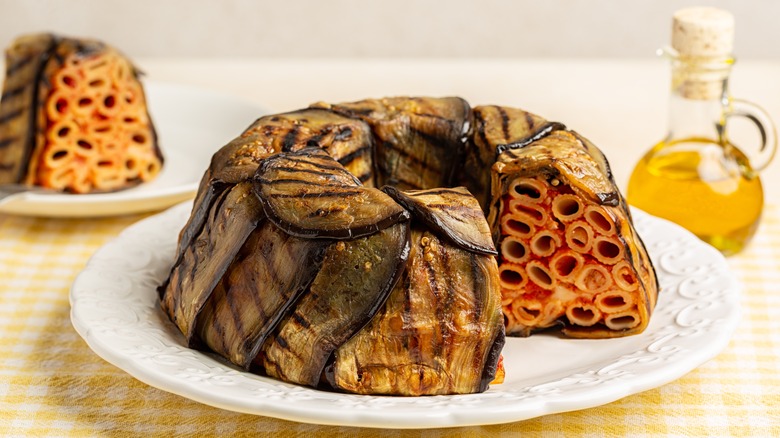
OlgaBombologna/Shutterstock
While Italian classics like spaghetti Bolognese or cacio e pepe are a staple on Italian American restaurant menus, there is a lesser-known Italian dish that never reached the same level of ubiquity: timballo. Though the dish had a surge of popularity in the mid-1990s after appearing in the film "Big Night," it quickly faded back into obscurity due to the dish's time-consuming nature.
There are many varieties of timballo, but at the most basic level it is a pasta dish baked in a mold with the addition of typical ingredients like meatballs, pheasant, or even luxury add-ons like truffles. For those with simpler tastes, you can also opt for timballo Genovese, which is a mix of cooked pasta, tomato sauce, and meatballs. No matter the variety, once cooked, the loaf-like pasta is sliced and served almost like cake, giving it a unique texture compared to most traditional Italian pasta dishes.



